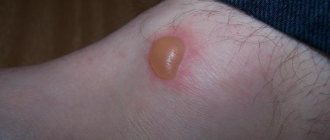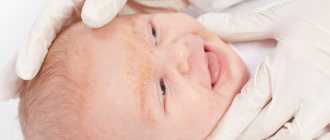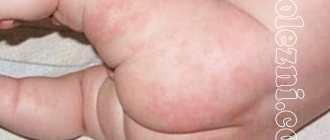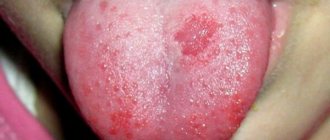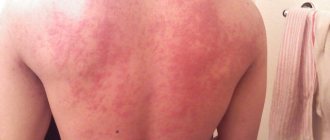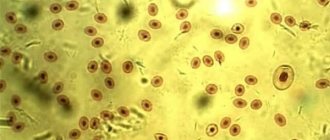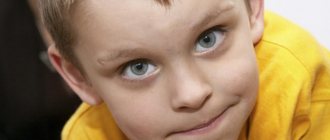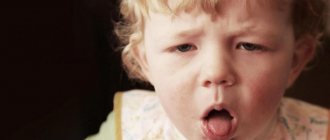Types and nature of the rash
Rash on the back - red spots, pimples, pimples, bumps, watery blisters, pink blisters, pustules. They can be localized only on the shoulder blades, for example, or involve the entire back.
The color of the rash varies from pale pink to red and brown. They may be accompanied by itching, but not always.
A rash on the lower back of a child has age-related characteristics and is conventionally divided into rashes in newborns, children under one year old and after one year. Each disease has its own manifestations, and they may not be related to each other.
Small
It can be a manifestation of a number of diseases that occur immediately after childbirth. A small rash on a child’s back usually does not bother him. 20% of all newborns develop neonatal pustulosis. This pathology is non-contagious and occurs only in the first days of life.
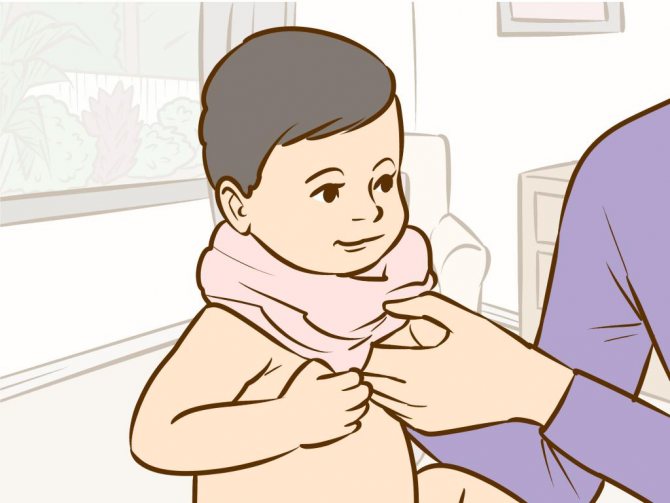
Another minor rash is miliaria. It requires only hygiene procedures and regular changes of clothes made from natural fabrics. Pathology indicates a violation of thermoregulation. Subsequently appears due to skin irritation.
What causes a rash on the back in children?
The causes of the rash can be internal and external factors. After determining the cause, doctors choose a form of treatment. Different types of rashes on a child’s back are shown in the photo with explanations. The variety of causes ranges from malnutrition, the introduction of new foods to the diet, to the appearance of pathologies in internal organs.
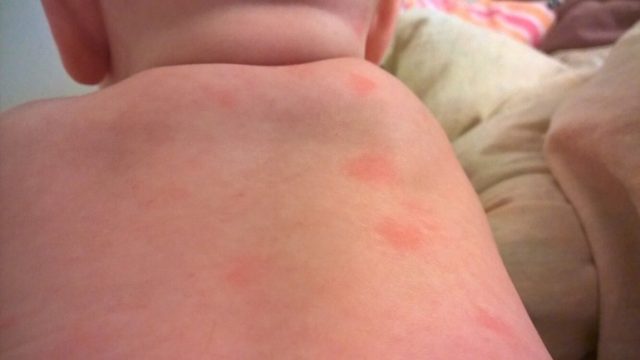
The main causes of rashes on the back in children:
- hormonal imbalances that occur in children of puberty;
- insufficient hygiene, which causes blockage of the sebaceous glands and their inflammation begins;
- infectious diseases - measles, scarlet fever, chickenpox;
- lichen if children come into contact with stray animals;
- eczema, causing severe itching for a long time, with skin hyperemia;
- psoriasis, in which scales appear on the skin along with a rash in small patches or large areas;
- folliculitis - inflammation of the hair follicles of the skin;
- endocrine diseases;
- allergic manifestations;
- eating disorder.
Need to know!
A rash can appear when the skin stops breathing. This happens if parents wrap the child up or put tight clothes on him that cause increased sweating.
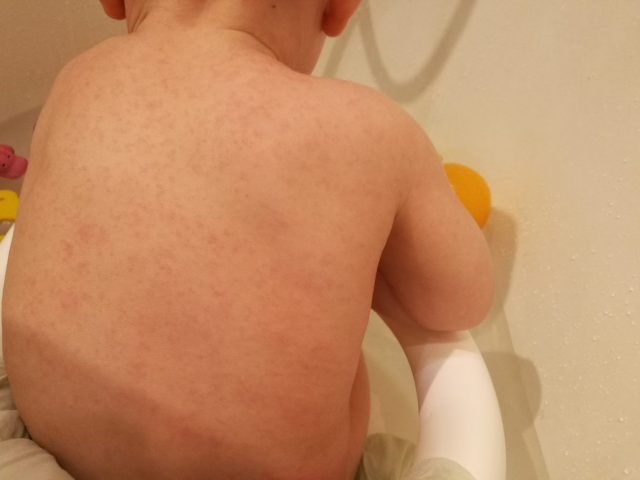
A sudden change in climate or a trip to hot regions can cause a profuse rash on the back, especially if the child is exposed to the sun for a long time on the beach and is exposed to unusually strong exposure to ultraviolet rays. This causes burns and a rash on the child’s back, as can be seen in the photo with explanations.
Other factors
Why does a child develop a rash on his back? The causes may be parasitic pathologies, for example, scabies.
Disruption of the gastrointestinal tract can also cause rashes. The reason may be:
- psoriasis, Lyme disease, herpes, syphilis;
- hormonal changes during puberty (more often occurs in boys and depends on increased levels of testosterone in the blood);
- neurodermatitis;
- diabetes;
- rash after massage;
- meningitis;
- insect bites.
A rash on the lower back of a child can occur when the immune system is weakened. The reasons are physical and mental overstrain in the student, poor nutrition, and lack of sleep. A reaction to increased ultraviolet radiation in children in the form of a rash on the lower back is rare.
Rash in children under one year of age
The most common problems parents face are:
- allergy;
- diaper rash;
- prickly heat;
- neonatal pustulosis;
- acne of newborns.
The last 2 points are not diseases, but manifestations of physiology, and they do not require treatment, they disappear on their own. They are associated with the influence of maternal hormones.
Allergic dermatitis, eczema and psoriasis are practically never found in newborns.
An allergic rash is a condition that can appear instantly, in less than a day. Before 3 months, hereditary predisposition to allergies does not appear. In infants, allergies are often associated with the introduction of complementary foods and improper nutrition of the baby's mother.
If during sleep a child sleeps on woolen blankets, feather beds, wears clothes made of artificial fiber, or his clothes are washed with cheap and low-quality powders, allergic dermatitis may appear. Therefore, you should be careful when choosing funds. It is necessary to select a blanket, pillow, and mattress for your baby with special care.
Diaper rash appears where the skin most often comes into contact with rough tissue, feces or urine. This condition is called diaper dermatitis and causes a rash on the baby's lower back. Skin lesions appear first on the butt, then on the back and abdomen. With a large area of damage, the child becomes restless, constantly cries, and refuses to breastfeed.
A rash on the lower back of a one-year-old child is often caused by prickly heat. It can be local or appear in many places in the body at once.
The rash is small, in the form of reddish nodules, and can be on the child’s back, neck, or chest.
The temperature does not rise, the child’s mood does not change, and his appetite does not disappear. Treatment and causes of rash on a child’s back are interrelated.
Causes
A rash on a child’s back can occur as a result of a huge variety of different causative factors.
A healthy baby's skin is pale pink in color and there are no rashes on it. If parents notice the appearance of a rash on the baby’s skin, they should definitely show the child to the doctor. The doctor will be able to establish the correct diagnosis and prescribe appropriate treatment.
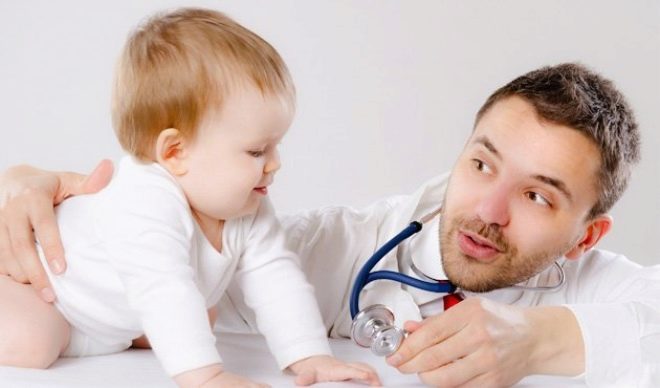
A rash on the skin of the back can appear at any age. The reasons that cause its appearance in newborn babies may differ markedly from those that contribute to the development of skin rashes in teenage children.
Quite often, various allergic pathologies lead to the development of rashes on the back and neck in children. They occur in children who have an individual predisposition to exposure to various allergens.
Atopic dermatitis is manifested by the appearance of skin rashes on the back, shoulders and abdomen. This condition occurs as a result of exposure to allergens of plant, animal or chemical origin. The appearance of the rash is preceded by severe itching and excessive dryness of the skin.
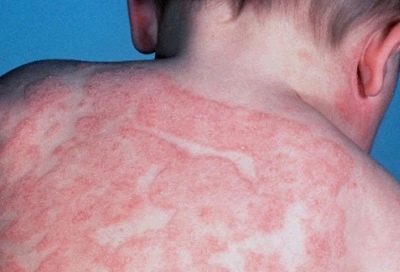
Atopic dermatitis in young children is quite often a consequence of the use of low-quality children's cosmetics used for daily hygiene procedures.
In the youngest patients, miliaria causes red or white rashes to appear on the back. This condition occurs due to excessive wrapping of the child in warm clothes.
The imperfect functioning of the thermoregulatory system of the child’s body contributes to rapid overheating after a fairly short period of time. The symptoms manifest themselves most clearly in babies in the first months of life.
Specific childhood infections are, perhaps, quite common causes of the appearance of various types of skin rashes in babies.
Chicken pox is accompanied by the development of rashes that are localized on the skin of the back, as well as on other parts of the body of the sick child. The appearance of skin rashes is preceded by an incubation period, during which practically nothing bothers the baby. Chickenpox is much more severe in schoolchildren than in children attending kindergarten.
READ ALSO: Facial care after 40 years
Rubella is one of the infectious pathologies that also develops quite often in children. Children who have not had previous vaccinations are at increased risk.
Children attending children's educational institutions are more likely to become infected. The classic manifestation of rubella is the appearance of a bright rash that is localized on the back, as well as on many other parts of the body.
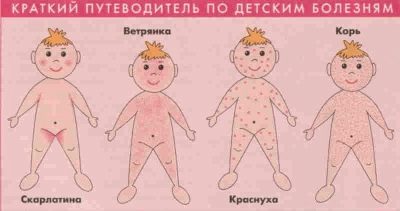
Bacterial infections quite often cause signs of vesiculopustulosis to appear on the skin of a sick baby. These skin rashes look like numerous blisters containing pus.
The course of the disease is usually severe. In some cases, purulent formations may open, and the pus present in them flows out, forming ulcers on the skin. To eliminate adverse symptoms in this case, the use of antibiotics is required.
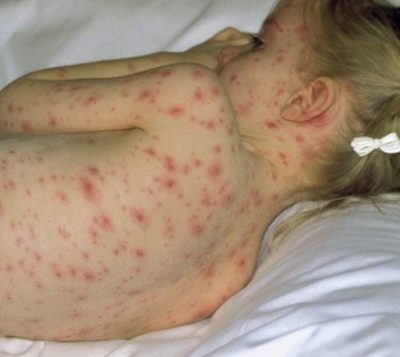
It's not just bacteria that causes rashes. Fungal flora is also quite often the root cause of the appearance of a specific rash on the skin. It can be localized in various parts of the child’s body, including on the back.
Such elements look like scaly neoplasms that can itch, thereby bringing severe discomfort to the child. To eliminate adverse symptoms, long-term administration of antifungal and immunostimulating drugs is required.
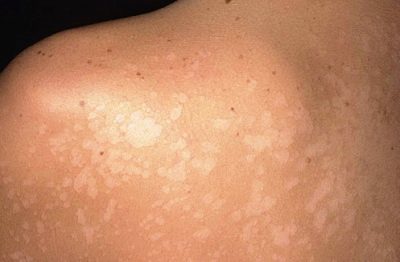
Diseases of the internal organs are the “silent” cause of the appearance of characteristic rashes on a child’s skin. The appearance of formations on the skin is quite common in endocrine pathologies. Children with diabetes or severe metabolic disorders are at increased risk.
Changes in the functioning of the reproductive organs also lead to the appearance of various pimples or even pustules on the child’s skin. This most often occurs during puberty.
Scientists believe that an increase in testosterone levels leads to the development of such purulent elements on the back of adolescents. According to statistics, such skin rashes are more common in boys.
The explanation for this is the physiologically initial high level of testosterone in the male body.
Measles infection is also a very common cause, which leads to the appearance of various skin rashes on the healthy and clean skin of the baby.
READ ALSO: Black spots in a child: on the face, head, under the arms
Most often, children of preschool age get sick with this infectious disease. The high-risk group includes babies who have not previously been sick, as well as babies who, for some reason, do not have up-to-date vaccinations.
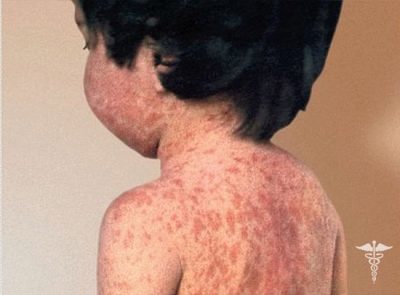
Sudden exanthema is a viral pathology that causes various rashes on the child’s skin. Scientists have found that the cause of this pathology is the effect of herpes viruses of subtype 6 on the body. The predominant localization of the rash with this infection is on the chest and back. Sudden exanthema, according to statistics, more often occurs in children with signs of immunodeficiency.
Scarlet fever can also cause characteristic rashes to appear on a child's skin. In some cases, a rash due to this infection may appear on the baby’s back. Usually the disease is quite severe with severe symptoms of intoxication.
Rashes on the back in children after one year
After a year, the child’s contacts with the outside world expand noticeably; older children go to kindergarten and school. In this age group, the appearance of a rash is of epidemic importance because infections occur.
At this age, we can conditionally distinguish 2 largest groups of causes: infections and allergies.
Children's infections are measles, rubella, chickenpox, scarlet fever. A rash on the back with them is a mandatory symptom. These diseases are almost always accompanied by fever, poor general condition, and intoxication. They are contagious, so quarantine is necessary.
Causes of acne on the back in children
Acne on a child's back appears as a result of increased activity of the sweat glands, as well as exposure to external and internal factors. Sometimes a rash on the back has nothing to do with acne, but is a symptom of other diseases .
Factors
Most often, teenagers 12-18 years old who are going through puberty suffer from acne on the back. Hormonal changes in the body affect the production of sebum, which is the main cause of acne.
Other factors include:
- diseases of the gastrointestinal tract;
- poor nutrition;
- insufficient hygiene;
- frequent stress;
- demodicosis (skin damage by acne mites);
- hereditary factors;
- use of certain medications;
- wearing synthetic clothing.
Rashes and small pimples
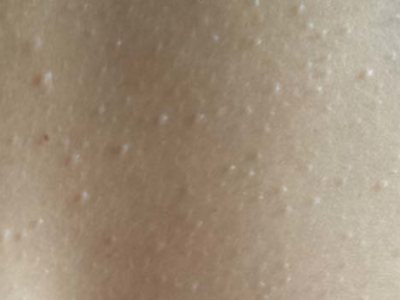
Often, newborn babies develop a neonatal rash - small pimples that can be localized on the back, face and other parts of the body.
This skin defect is associated with the child’s adaptation to the outside world, does not pose a danger to him and goes away on its own after a few weeks or months.
Red pimples

Allergic skin rashes can take various forms: from common urticaria to eczema. A distinctive feature of such rashes is itching , which causes anxiety to the child.
One of the most common causes of rashes on the back of an infant or young child is prickly heat, a type of dermatitis that occurs due to overheating of the body and insufficient hygiene.
Watery pimples
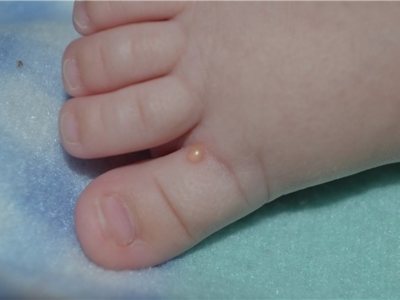
You can see an example of these pimples on the left, they usually look like burn blisters.
As a rule, rashes are accompanied by itching, elevated body temperature and symptoms of intoxication of the body.
Pimples on a child's back itch
Severe skin itching is caused by an allergic rash, dermatitis or infectious rashes. Regular pimples (acne) usually do not itch.
Any skin rash in a child requires immediate medical consultation!
Diseases
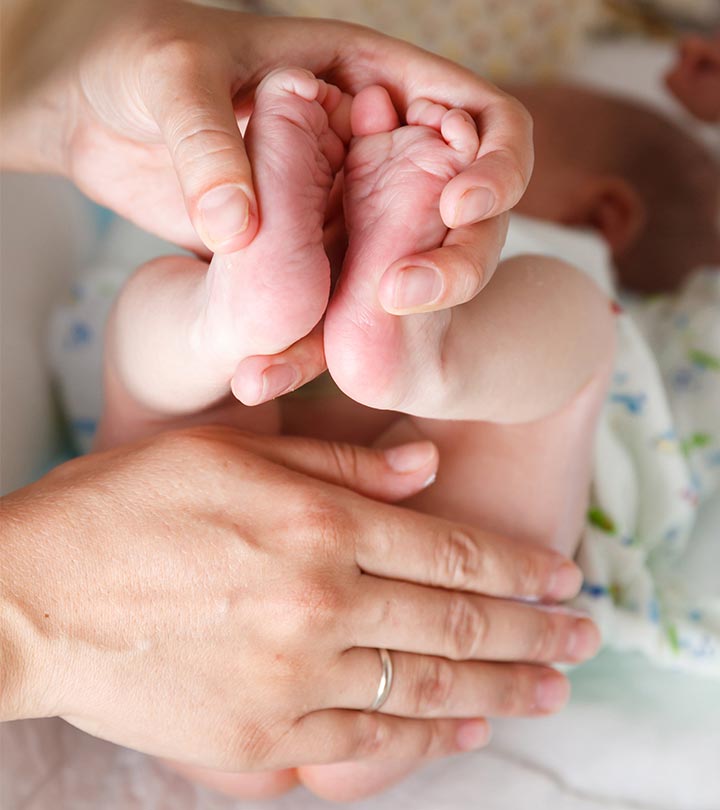
The simplest and most harmless rash on the lower back of a child is prickly heat. It occurs not only on the back, but also in the folds of the skin, the back of the head, the shoulders, i.e. where there are a lot of sweat glands. It is the result of a violation of thermoregulation, which is imperfect in a small child.
The baby's body overheats, and a small, pinpoint rash with itching appears. Its treatment is also very simple. You should bathe your child in a decoction of string, calendula or chamomile. Then you need to get the baby wet and treat the skin with a drying agent, such as talc or powder. At the end, the child is changed into lighter natural clothes so that the skin can breathe. These measures are usually sufficient.
With vesiculopustulosis or pyoderma, a small pustular rash appears. It can be not only on the back.
Rubella is a viral infection. Rashes in the form of small pink spots. Body temperature may rise slightly and catarrhal symptoms appear.
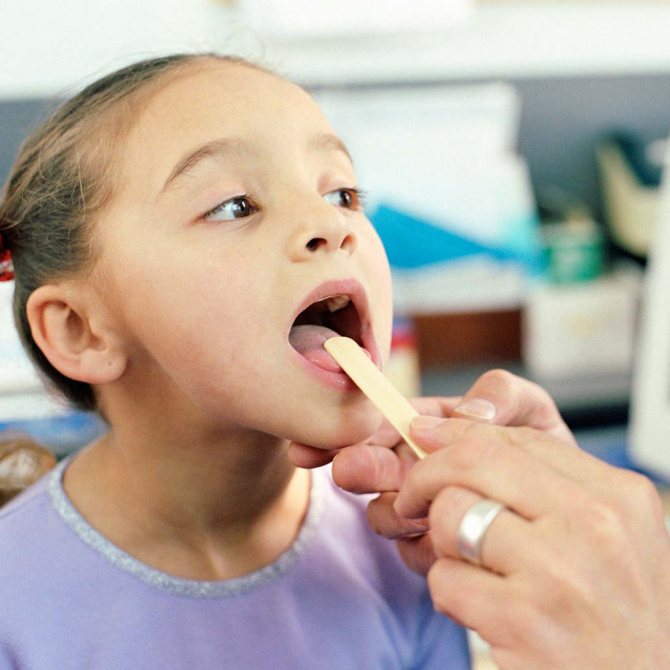
Scarlet fever is caused by hemolytic streptococcus and is contagious. A small pink rash appears on the child’s lower back. A characteristic sign is that from 2-4 days of illness the tongue becomes bright crimson. Fever, intoxication and signs of sore throat are also noted. The diagnosis, according to doctors, can be made even in the dark: just run your hand over the skin: the scarlet fever rash resembles fine sandpaper.
Chicken pox is caused by herpes type 3. Colorless blisters with liquid appear on the skin, and sometimes they can itch. Then, after some time, the bubbles burst, and these places become covered with a crust. The general condition is often not disturbed. Locations are not only on the back, but throughout the body. Those who have recovered from the disease develop lifelong immunity. Otherwise, infection occurs in 100% of cases through contact with a patient.
Ringworm is a fungal infection of the skin. A rash in the form of spots with pimples of pus.
Measles is dangerous for unvaccinated children. On the 5th day of illness, a red-spotted rash appears not only on the back, but also throughout the body. Closer to the feet it decreases. The spots tend to merge. They are preceded by fever (more than 39 degrees), sore throat, cough, runny nose.
Meningitis is a very dangerous meningococcal infection in children. With it, the temperature rises sharply, the state of health worsens, vomiting appears, and consciousness is impaired. Rash in the form of small hemorrhages. Meningeal symptoms are manifested in the stiffness of the neck muscles - when bending the chin, the legs move, etc. Meningitis requires urgent hospitalization.
Roseola or sudden exanthema is caused by herpes type 6. It occurs suddenly in children with signs of immunodeficiency. The temperature rises sharply above 39 degrees, but the general condition is not disturbed. 5 days after this, the back and chest become covered with a small pink rash. No treatment is required, the rash disappears on its own.
Scabies is caused by the scabies mite. You can become infected with it in any public place. The rash is accompanied by severe itching, which intensifies in the evening. This is due to the activation of the mite, which crawls in the upper layer of the dermis and gnaws its passages. From time to time it creeps out to the surface of the skin. Therefore, this rash seems to be paired - the “entrance” and “exit” are visible.
Allergic rash in children. It occupies a large group of skin lesions on the back. They are collectively called allergic dermatoses.
Children under the age of 3-4 years most often suffer from atopic dermatitis (diathesis, infantile eczema), strophulus (papular urticaria) and urticaria (acute and chronic), contact dermatitis and exudative erythema.
Allergic dermatosis develops in the form of an abnormal skin reaction both with a single contact with an allergen and with its regular exposure. Single contact leads to acute urticaria and Quincke's edema. Allergens can be very different, they have already been discussed.
Most often, the provocateur is a foreign protein. Usually cow's milk (casein) when introducing complementary foods. Predisposing factors include chronic gastrointestinal disorders, heredity, intestinal dysbiosis, and poor environment.
What does it look like?
Rashes on the back can vary in appearance. Most infectious pathologies manifest as a red rash. Usually the skin elements are very itchy and significantly worsen the child’s well-being. In some cases, a colorless rash also occurs, but this condition is registered in children relatively less frequently.
White or reddish skin lesions that appear on the back and neck may be a manifestation of miliaria. Usually this condition is caused by a violation of thermoregulation and manifests itself in the youngest children.
Wearing warm clothes in a fairly hot season disrupts the heat exchange of the skin, which leads to the development of excessive sweating in the baby. Ultimately, this causes the appearance of fairly large rashes that are localized on the baby’s back and chest.
Fungal rashes appear as multiple formations, which can have a variety of sizes. In some cases, these elements merge with each other, forming areas with very unusual shapes and outlines.
of lichen lead to the development of skin rashes . After cleansing the skin of such elements, white areas remain on it, which do not tan well when exposed to sunlight. Skin rashes of fungal etiology usually cause severe itching in the child, which brings severe suffering to the baby.
READ ALSO: Hand allergies in adults: how to cure at home
purulent blisters may form on the skin . Typically, this condition is registered in children between 10 and 15 years of age. The size of such rashes usually does not exceed a few millimeters.
Careless contact can lead to the leakage of pus from such a vesicle and the penetration of a secondary bacterial infection into the cavity. In this case, the course of the disease worsens significantly.
Allergic
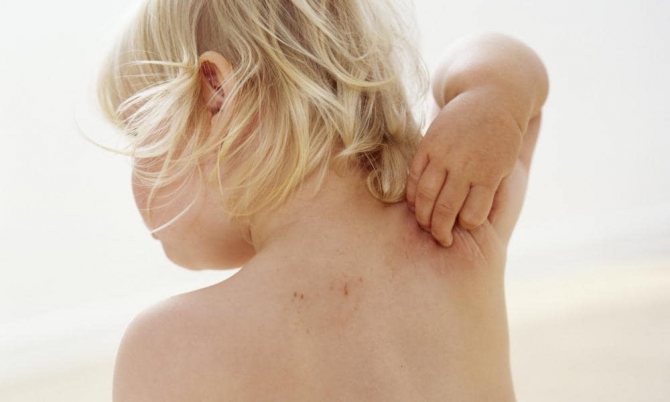
Atopic dermatitis is a prolonged allergic skin reaction. Characteristic signs are itching, scratching of the epidermis, blisters and weeping.
When infected, the lesion expands. The current is most often wavy.
With strophulus, the rash is in the form of dense red nodules, with itching. Sometimes pimples develop into a blister, which leaves brown crusts after healing.
Rashes due to diseases of the blood and blood vessels
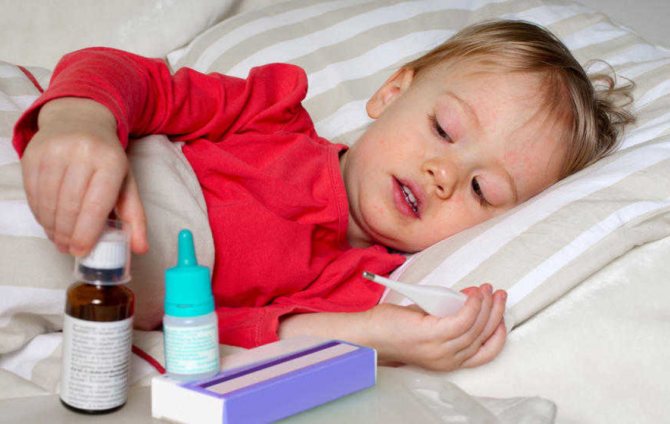
With these pathologies, a hemorrhagic rash in the form of small red spots becomes characteristic. This is a manifestation of hemorrhages into the skin of damaged blood vessels. They can occur due to increased permeability and a decrease in platelets.
The most common is hemorrhagic vasculitis, an inflammatory disease of the walls of microvessels. Usually occurs in children under 5 years of age. The affected areas seem flat, but to the touch the elements of the rash rise above the skin.
Self-treatment is impossible; it can only be done in a hospital. Children with this pathology are not advised to stay in the sun, physiotherapy, or sports.
Parental behavior
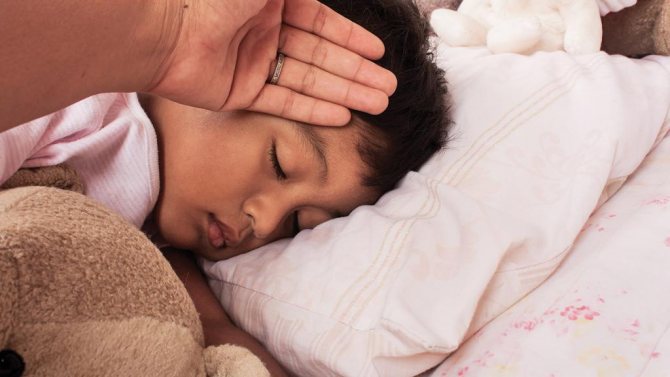
How to recognize the disease in a child with a rash on the back? Only a doctor can do this, even if you have incredible experience in caring for children, you cannot do this yourself.
If a rash appears, do not cover it with aniline dyes; call a doctor and isolate the child from contact with other family members.
A rash is a manifestation of internal disorders, and lubrication is a symptomatic measure. The cause will not go away, so seeing a doctor is necessary.
Allergic rashes on the back
Skin lesions on the back are common. The true causes are different: allergies, infectious diseases, dermatitis, eczema, lupus and others. If rashes occur, you should consult a doctor to identify the exact cause; treatment depends on this. Back allergies in adults are often caused by the use of alcohol and tobacco.
Allergic reactions on the skin manifest themselves in different ways:
- peeling;
- redness, spots;
- The rash is dry or weeping;
- acne, ulcers.
If left untreated, the rash will spread to other areas of the skin. The danger is the accumulation of allergen in the body; skin rashes are accompanied by other manifestations of the immune response. The most dangerous is Quincke's edema, which can be fatal.
